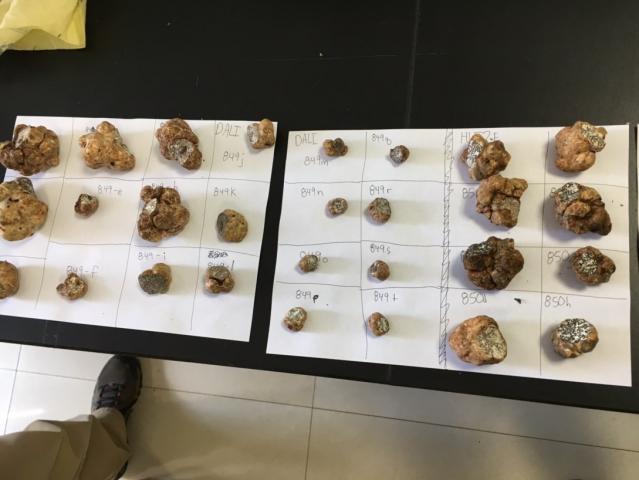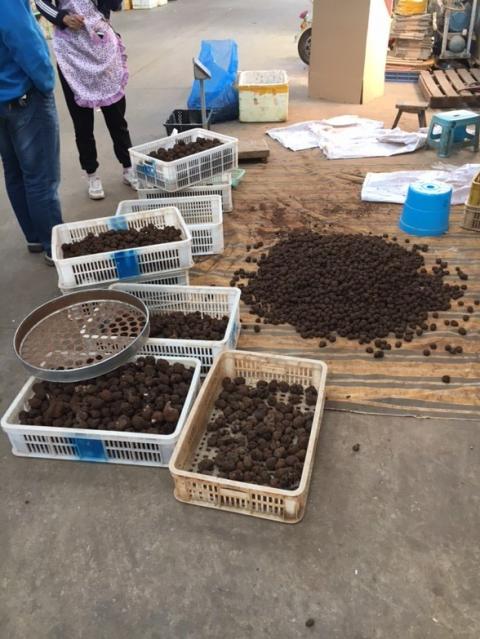Out and about with the project team - Spring extension activities
The project team continues to regularly update the industry on our activities and this spring we’ve presented at the annual Australian Truffle Growers Association (ATGA) conference as well as a Truffle Producers of Western Australia (TPWA) field walk. The Pest and Disease info page on the DPIRD website has also been updated.
ATGA Conference – Ballarat November 13-15
The Truffle Pest and Disease project was well represented at this year’s ATGA conference in Ballarat. Alan Davey, Alison Mathews and Anne Mitchell ran a Pest and Diseases Workshop and Research Communication at Oakhill Truffles on the Friday, with guest presenter Peter Del Santo who discussed some of the principles involved in pest management. With the exception of Peter, each also made a presentation at the more formal part of the conference on Saturday and were available during the Sunday field walks to answer questions and talk to growers.
The Workshop focussed on the main pests of truffles and methods of controlling them. Oakhill Truffles is a monitoring site for the project so we explained the use of pitfall and tiles traps and encouraged growers to undertake monitoring on their own properties. An information pack on this is available on the DPIRD website.
Alan Davey and Alison Mathews both gave presentations on the field and lab work that has been taking place this year, with perspectives from eastern and Western Australia. Results were similar with slugs and slaters being the most widespread and prolific pests. The indications are by making the truffle orchard habitat less suitable for these pests, their numbers will reduce, resulting in less damage to truffles. Growers were encouraged to undertake their own monitoring as we have found that while there are trends across many of our monitoring sites, each orchard has its own peculiarities in terms of the type, number and seasonality of its pests.
Anne Mitchell spoke on the results of part of the national truffle grower questionnaire survey that was undertaken in 2015/16. There were 118 respondents across Australia, covering some 200,000 trees. An analysis of planting dates showed that while there has been continuous planting since 1997, there is a peak of planting from 2009 to 2012. This indicates that production will continue to increase for the foreseeable future. The vast majority of growers have planted trees inoculated with Tuber melanosporum, with smaller numbers of growers planting trees inoculated with T. borchii, T. aestivum and/or T. magnatum. Loam and loamy soils were the main soil types identified in truffle orchards with sand being the next most common. Irrigation was highly variable with some growers irrigating daily while others irrigate fortnightly.
Reports of pests and diseases were summarised, along with observed damage. Orchard floor management appears to be an important strategy in reducing truffle pest numbers. Less than half of growers actively manage the leaf litter. The role of cultivation of the orchard floor in production of truffles, or weed management is the subject of much research, both here in Australia and in Europe. Less than half of the responding truffle growers reported cultivating. Management of shallow or exposed truffles has been shown to reduce the incidence of truffle damage, specifically truffle rot. Two thirds of responding growers indicated some covering of exposed or shallow truffles.
Further analysis of the surveys is underway and will be reported in 2018.
TPWA Field Walk – 28th October 2017
For WA growers unable to make it to the Ballarat conference, Alison Mathews gave a similar presentation to the one she gave in Ballarat. Wintery weather turned the field walk into a shed talk but this didn’t dampen the discussion. Alison’s talk discussed results of the recent slug and slater field trials and truffle damage data from the 2017 harvest in Western Australia.
China Conference
Anne Mitchell was invited to present at the 5th International Truffle Festival and Congress held in Nujiang, Yunnan Province 6-9 November 2017. This was a fantastic opportunity to hear about truffle research that is taking place globally and meet the people involved.
Some key points from the conference were:
- The Chinese scientific community are very active in truffle research and actively collaborating with truffle scientists around the globe, including France, the US, Spain, Taiwan and Mexico.
- The Chinese have a developing interest in their native truffles both black and white. Many of those truffles have traditionally been used for medicinal or health purposes.
- Historically truffles have been harvested by raking but this practice is now being discouraged in favour of using dogs.
- There are at least 50 species of native Chinese truffle that are being investigated. Recently some of these are being used in truffle orchards, particularly Tuber indicum.
- Truffle scientists are just beginning to address the issue of pests in truffles. They were keen to understand the role of pest management in establishing orchards.
- While they have been researching inoculation techniques since the 1980’s, their current production is largely based on truffle from native forests. Reports of Chinese truffle entering the European market range from 30 to 200 tonnes per year.

Pest and Disease Info Page Update
During 2017, we learned that truffles may be damaged by a range of pests not previously thought to be important. These and other changes have been included in an updated version of the bulletin on Pests and Diseases of Truffles and their Host Trees on the DPIRD web page.
As mentioned in other sections of the Newsletter, we have also added a note on ‘do it yourself’ truffle pest monitoring, with an emphasis on the main truffle pests – slugs and slaters.

